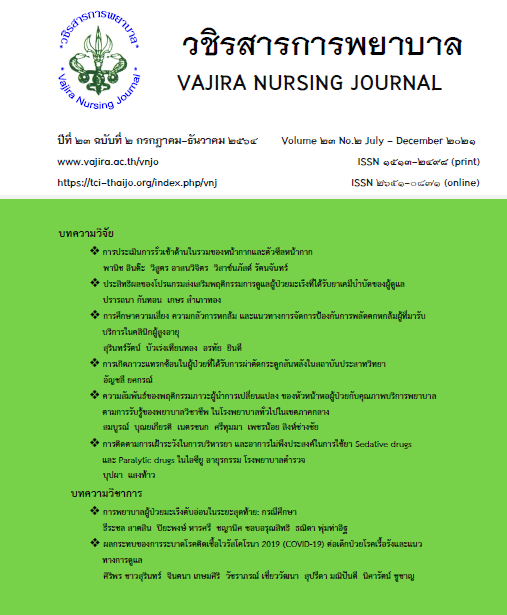การศึกษาความเสี่ยง ความกลัวการหกล้ม และแนวทางการจัดการป้องกัน การพลัดตกหกล้มผู้ที่มารับบริการในคลินิกผู้สูงอายุ
Main Article Content
บทคัดย่อ
การพลัดตกหกล้มเป็นปัญหาที่สำคัญทางสาธารณสุขทั่วโลก ส่งผลให้ผู้สูงอายุได้รับบาดเจ็บเกิดความพิการ และเสียชีวิตตามมา การศึกษาครั้งนี้เป็นการศึกษาเชิงบรรยาย เพื่อศึกษาความเสี่ยง ความกลัวการหกล้ม และแนวทางการจัดการป้องกันการพลัดตกหกล้มในผู้สูงอายุ กลุ่มตัวอย่างเป็นผู้สูงอายุที่เข้ารับการรักษาในแผนกผู้ป่วยนอกคลินิกผู้สูงอายุ โรงพยาบาลกลาง จำนวน 165 คน มีคุณสมบัติตามเกณฑ์คัดเข้า ทำการสัมภาษณ์ด้วยแบบบันทึกข้อมูลทั่วไป แบบประเมินความเสี่ยงต่อการพลัดตกหกล้ม
แบบประเมินการกลัวการหกล้ม และแบบประเมินแนวทางป้องกันการพลัดตกหกล้ม ได้ค่าสัมประสิทธิ์แอลฟาของครอนบาค เท่ากับ .76 และวิเคราะห์ข้อมูลโดยใช้โปรแกรมคอมพิวเตอร์สำเร็จรูปด้วยสถิติบรรยาย
ผลการศึกษาพบว่า ผู้สูงอายุส่วนใหญ่มีระดับความเสี่ยงการพลัดตกหกล้มอยู่ในระดับปานกลางร้อยละ 57.0 มีระดับความกลัวการหกล้มระดับมาก ร้อยละ 50.3 และกิจกรรมที่กลัวการหกล้มมากที่สุดคือการเดินบนพื้นลื่น (= 2.03, SD = 0.9) และส่วนใหญ่ผู้สูงอายุมีรูปแบบการป้องกันการพลัดตกหกล้มคือการจัดสภาพแวดล้อม ร้อยละ 87.3 แต่รูปแบบการป้องกันการพลัดตกหกล้มที่พบน้อยที่สุดคือการออกกำลังกายอย่างสม่ำเสมอ เสริมสร้างกล้ามเนื้อ และกระดูก ร้อยละ 21.2 ข้อเสนอแนะจากการวิจัยครั้งนี้ สามารถพัฒนารูปแบบการจัดการพลัดตกหกล้มให้เหมาะสมกับผู้สูงอายุที่เข้ารับการรักษาในคลินิกและการพยาบาลเวชปฏิบัติชุมชนเพื่อป้องกันการหกล้มของผู้สูงอายุในชุมชนต่อไป
Article Details
เนื้อหาและข้อมูลในบทความที่ลงตีพิมพ์ในวชิรสารการพยาบาลถือเป็นข้อคิดเห็นและความรับผิดชอบของผู้เขียนบทความโดยตรง ซึ่งกองบรรณาธิการไม่จำเป็นต้องเห็นด้วย หรือร่วมรับผิดชอบใด ๆ ทั้งสิ้น
บทความ ข้อมูล เนื้อหา รูปภาพ ฯลฯ ที่ได้รับการตีพิมพ์ในวชิรสารการพยาบาล ถือเป็นลิขสิทธิ์ของวชิรสารการพยาบาล หากบุคคลใดหรือหน่วยงานใดต้องการนำทั้งหมดหรือส่วนหนึ่งส่วนใดไปเผยแพร่ต่อหรือเพื่อกระทำการใด ๆ จะต้องได้รับอนุญาตเป็นลายลักอักษรจากวชิรสารการพยาบาลก่อนเท่านั้น
เอกสารอ้างอิง
กนกวรรณ เมืองศิริ, นิภา มหารัชพงศ์และยุวดี รอดจากภัย. (2560). ปัจจัยที่มีความสัมพันธ์ต่อพฤติกรรมการ ป้องกันการหกล้มของผู้สูงอายุจังหวัดสระบุรี.วารสารมหาวิทยาลัยนเรศวร;วิทยาศาสตร์และเทคโนโลยี, 4(25), 23-33.
กมลพร วงศ์พนิตกุลย์. (2555). ปัจจัยที่มีความสัมพันธ์กับความกลัวการหกล้มของผู้สูงอายุที่อาศัยอยู่ในชุมชน จังหวัดกาญจนบุรี. (วิทยานิพนธ์พยาบาลศาสตรมหาบัณฑิต, สาขาวิชาการพยาบาลผู้สูงอายุ, บัณฑิตวิทยาลัย, มหาวิทยาลัยบูรพา).
ชื่นจิตร กองแก้ว. (2557). รายงานวิจัยฉบับสมบูรณ์ การใช้ยาในผู้สูงอายุไทยเขตภาคเหนือตอนล่างประเทศไทย.[อินเตอร์เน็ต]. [เข้าถึงเมื่อ 11 มีนาคม 2564]. เข้าถึงได้จาก https.//www.RAC56002%20- %20ผศ.ดร.ภญ. ชื่นจิตร_การใช้ยาในผู้สูงอายุไทยเขตภาคเหนือตอนล่างประเทศไทย%20(1).pdf
ดาราวรรณ รองเมือง, ฉันทนา นาคฉัตรีย์, จีราพร ทองดี และจิตติยา สมบัติบูรณ์. (2559). อุบัติการณ์ของการหกล้ม และปัจจัยที่มีความสัมพันธ์กับการหกล้มในผู้สูงอายุที่อาศัยในชุมชน จังหวัดสุราษฎร์ธานี. วารสารวิทยาลัยพยาบาลพระปกเกล้าจันทบุรี, 27(ฉบับเพิ่มเติม), 123-138.
นารีรัตน์ จิตรมนตรี, สาวิตรี ทยานศิลป์ และสิริวัลย์ เรืองสุรัตน์. (2551). บทสรุปจากเวทีสาธารณะ: การเตรียม พร้อมระบบสวัสดิการสำหรับสังคมผู้สูงวัย. กรุงเทพฯ: มิสเตอร์ก๊อป.
นงนุช วรไธสง. (2557). ปัจจัยที่เกี่ยวข้องกับการหกล้มในผู้สูงอายุกลุ่มเสี่ยงที่อาศัยอยู่ในชุมชน (วิทยานิพนธ์). ขอนแก่น:มหาวิทยาลัยขอนแก่น
มูลนิธิสถาบันวิจัยและพัฒนาผู้สูงอายุไทย (มส.ผส.). (2563). สถานการณ์ผู้สูงอายุไทย พ.ศ. 2562. นครปฐม: สถาบันวิจัยประชากรและสังคม มหาวิทยาลัยมหิดล.
มูลนิธิสถาบันวิจัยและพัฒนาผู้สูงอายุไทย (มส.ผส.). (2564). สถานการณ์ผู้สูงอายุไทย พ.ศ. 2563. นครปฐม: สถาบันวิจัยประชากร และสังคม มหาวิทยาลัยมหิดล
เยาวลักษณ์ คุมขวัญ, อภิรดี คำเงิน, อุษณีย์ วรรณลัย และนิพร ขัดตา. (2561). แนวทางการป้องกันการพลัดตกหกล้มที่บ้านในผู้สูงอายุ: บริบทของประเทศไทย. วารสารการพยาบาลสาธารณสุข, 28(3),10-22.
ละออม สร้อยแสง, จริยาวัตร คมพยัคฆ์ และกนกพร นทีธนสมบัติ. (2557). การศึกษาแนวทางการป้องกันการหกล้มในผู้สูงอายุชุมชนมิตรภาพพัฒนา.วารสารพยาบาลทหารบก, 15(1), 122-129.
ลัดดา เถียมวงศ์. (2554). การทดสอบคุณสมบัติของเครื่องมือประเมินอาการกลัวหกล้มในผู้สูงอายุไทย. สงขลานครนครินทร์เวชสาร, 29(6), 277-286.
ศิราณี ศรีหาภาค, วัชรี อมรโรจน์วรวุฒิ, ณรงค์ คำอ่อน, พัฒนี ศรีโอษฐ์, พลอยลดา ศรีหานู และทิพวรรณ ทับซ้าย. (2564). สถานการณ์ปัญหา และความต้องการการดูแลผู้สูงอายุระยะยาวในชุมชน ภายใต้กองทุนระบบการดูแลระยะยาว จังหวัดขอนแก่น. วารสารศูนย์อนามัยที่ 9, 15(36), 44-62.
สถาบันวิจัยประชากรและสังคม มหาวิทยาลัยมหิดล มูลนิธิสถาบันวิจัยและพัฒนาผู้สูงอายุไทย. (2559). สถานการณ์ผู้สูงอายุไทย พ.ศ. 2559. นครปฐม : พริ้นเทอรี.
สถาบันวิจัยประชากรและสังคม มหาวิทยาลัยมหิดล มูลนิธิสถาบันวิจัยและพัฒนาผู้สูงอายุไทย. (2556). สถานการณ์ผู้สูงอายุไทย พ.ศ. 2556. นครปฐม : พริ้นเทอรี.
สถาบันเวชศาสตร์ผู้สูงอายุ. (2551). แนวทางเวชปฏิบัติการป้องกัน/ประเมิน ภาวะหกล้มในผู้สูงอายุ. [อินเตอร์เน็ต]. [เข้าถึงเมื่อ 11 มีนาคม 2564]. เข้าถึงได้จาก:http://agingthai.dms.go.th/agingthai/wp-content/uploads/2021/01/book_8.pdf
สำนักงานสถิติแห่งชาติ. รายงานการสำรวจประชากรสูงอายุในประเทศไทย พ.ศ.2557. [อินเตอร์เน็ต].[เข้าถึงเมื่อ 11 มีนาคม 2564]. เข้าถึงได้จาก: http://service.nso.go.th/nso/nsopublish/themes/files/elderlyworkFullReport57-1.pdf
สำนักโรคไม่ติดต่อ กรมควบคุมโรค กระทรวงสาธารณสุข. รายงานการพยากรณ์การพลัดตกหกล้ม ของผู้สูงอายุ (อายุ 60 ปีขึ้นไป) ในประเทศไทย ปี พ.ศ. 2560 – 2564. [อินเตอร์เน็ต]. [เข้าถึงเมื่อ 1 มีนาคม 2564]. เข้าถึงได้จาก: http://www.thaincd.com/document/file/violence/การพยากรณ์การพลัดตกหกล้มในผู้สูงอายุ%20ปี%202560-2564.pdf.
สุทธิดา พงษ์พันธ์งาม และอัมภิชา นาไวย์. (2563). การหกล้ม ความกลัวการหกล้ม และการจํากัดกิจกรรมเนื่องจากกลัวหกล้ม ในผู้สูงอายุไทยที่อาศัยอยู่ในชุมชนชานเมืองเชียงใหม่. วารสารวิจัยสุขภาพและ การพยาบาล, 36(1), 22-38.
สุทธิพงษ์ รักเล่ง. (2560). การใช้ยาหลายขนานและการควบคุมระดับความดันโลหิตของผู้ป่วยความดันโลหิตสูงจังหวัดพัทลุง. วารสารเครือข่ายวิทยาลัยพยาบาลและการสาธารณสุขภาคใต้, 4(2), 77-93.
อัจฉรา ปุราคม และคณะ. (2558). โครงการศึกษารูปแบบกิจกรรมทางกายเพื่อลดความเสื่อมถอยของ สมรรถภาพการทำหน้าที่ทางกายผู้สูงอายุ. โดยการสนับสนุนจากศูนย์วิจัยกิจกรรมทางกายเพื่อสุขภาพ
สำนักงานกองทุนสนับสนุนการสร้างเสริมสุขภาพ (สสส.) [อินเตอร์เน็ต]. [เข้าถึงเมื่อ 2 พฤษภาคม 2564]. เข้าถึงได้จาก: http://padatabase.net/uploads/files/01/doc/556_2017-04-26.pdf
Bandura, A. (1997). Self-efficiency the exercise of control (4 th ed.). New York; W.H. Freeman.
Kempen, G. I., Yardley, L., van Haastregt, J. C., Zijlstra, G. A., Beyer, N., Hauer, K., & Todd, C. (2007). The Short FES-I: a shortened version of the falls efficacy scale-international to assess fear of falling. Age Ageing, 37(1), 45-50.
Knox-Vydmanov, C. (2017). Work, family and social protection: Old age income security in Bangladesh, Nepal, the Philippines, Thailand and Vietnam.
Malini, F. M., Lourenço, R. A., & Lopes, C. S. (2016). Prevalence of fear of falling in older adults, and its associations with clinical, functional and psychosocial factors: The Frailty in Brazilian Older People-Rio de Janeiro study. Geriatrics & gerontology international, 16(3),336–344.
Mishra, N.; Mishra, A.K.; Bidija, M. A. (2017). study on correlation between depression, fear of fall and quality of life in elderly individuals. International Journal of Research in Medical Sciences, 5(-), 1456–1460.
Stephen, H., & Andrew, G. (2011). Fear of falling. Australine Journal of Advanced Nursing, 27(1): 94-100.
Taro, Y., (1967). Statistics: An Introductory Analysis, 2nd Edition, New York: Harper and Row.
United Nations. World population aging. (2018). Retrieved 10 May, 2021, Available from http://www.un.org/esa/population/publication/WPA2009/WPA2009_WorkingPaper.Pdf.


